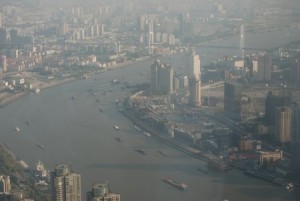
After spending 2 1/2 weeks visiting 8 Asian ports, we were looking forward to exploring Shanghai. On our first day, we combined time on the Hop On Hop Off bus with simple walks. We chose the City Sightseeing company with red double decker buses.
Like most Hop On Hop Off tours, we had the opportunity to get off the bus and get back on the bus at our leisure. However, the wait times and the crowds deterred us from taking full advantage of this option. On one occasion we waited more than 40 minutes for a bus and had to endure a significant amount of shoving and pushing. It should also be noted that the sign had conflicting end times. At the end of our day of touring, we waited for a bus. A good samaritan who could not speak English used hand language to let us know that the bus had stopped running. We ended up taking a taxis back to our hotel.
Despite these inconveniences, I enjoyed the opportunity to get a taste of what Shanghai had to offer.
The front desk of our hotel gave us inaccurate directions. We wandered about until we eventually found one of the bus stops. It was located near the Shanghai Urban Planning and Exhibition Hall.
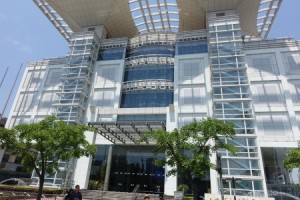
The bus was more crowded than we anticipated. At first, we were unable to find seats. The headphones did not work so we could not hear an English translation. Due to the crowds, it was a challenge to take pictures that were not obstructed or blurry.
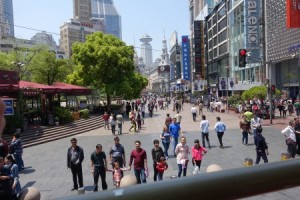
I captured this picture of an open area. I am assuming that it is the Nanjing Pedestrian Street, but I cannot be certain since I cannot read the Chinese signs.
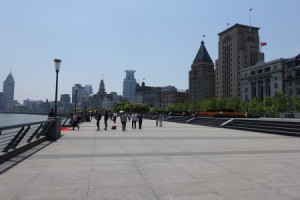
We exited the bus at The Bund, Shanghai’s waterfront trademark. This area has been considered the symbol of Shanghai for hundreds of years. The body of water on the left side of the boardwalk is the Huangpu River. The Bund area is located between the Waibaidu Bridge and the Nanpu Bridge, approximately a mile long.
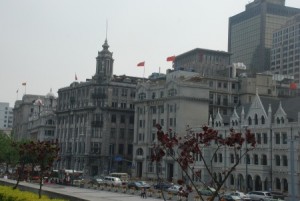
On the west side of the Bund are 26 buildings that have distinct architectural styles- Baroque, Classicism, Gothic, Renaissance, and Romanesque.
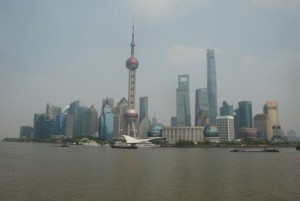
On the east side is a collection of modern buildings.
While walking on the boardwalk, we passed by several brides in bright red dresses. The bridal parties were taking advantage of the picturesque location.
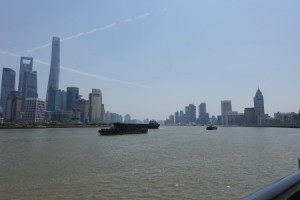
Different sized ships used the river as a thoroughfare.
When we reached the other end of the Bund, we tried to catch another bus. We waited and waited. Eventually, we took an uncrowded bus (yellow bustling 3) that took us across the Nanpu Bridge. In this less congested area we passed by several places.
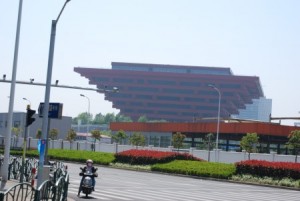
A number of people boarded the bus at the China Art Museum Shanghai one of the largest museums in Asia. We did not have sufficient time to explore their four main collections which include the Origin of Chinese Modern and Contemporary Art, Artworks Featuring Shanghai’s Historical and Cultural Development, the Artworks of Noted Painters, and Arts Development in the New Century.
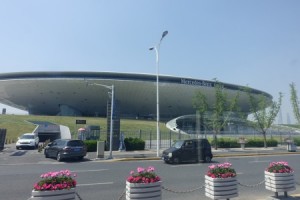
We also stopped in front of the the Mercedes Benz Arena, formerly known as the Shanghai World Expo Cultural Center. This facility holds 18,000 people.
Occasionally, we were able to capture some panoramic shots of Shanghai.

Bridges connected the former Expo area with the main part of Shanghai.

In the foreground is a park with the Nanpu Bridge in the background.
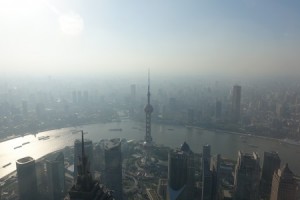
After the bus crossed the river we transferred to a the green line, bus #2. This route took us to the Lujiazui Financial and Trade Zone. This area is the urban centre of the Pudong District of Shanghai. It is home to most of Shanghai’s modern buildings and skyscrapers which include the notable Oriental Pearl TV Tower, the Jin Mao Tower, the Bank of China and the 101- story World Financial Center.
Unfortunately, by the time we reached this area, the sun was at a bad angle to capture panoramic scenes. The glare wrecked havoc with most of our pictures. Had we known that the bus would not be running by the time we reached the stop, we would have stayed to watch the sunset over Shanghai.
Pros and Cons of Hop On Hop Off Shanghai Buses
Pros
- Provides an overview of city
- Shortens amount of walking between locations
- Flexibility to visit several places within 24 hour time span
- Photo opportunities from upper deck
Cons
- Dependent on timeliness of service
- Lines and crowds may limit access and photo opportunities
- Poor signage may cause confusion
- May be difficult to find location of bus stops
- Translation of tour may not be available on all buses.
Related Posts
Sandra’s Bio
Sandra Bornstein is the author of MAY THIS BE THE BEST YEAR OF YOUR LIFE. It is available on Amazon. Sandra’s memoir highlights her living and teaching adventure in Bangalore, India. She is a licensed Colorado teacher who has taught K-12 students in the United States and abroad as well as college level courses. Sandra is married and has four adult sons. The memoir was a finalist in the Travel category for the 2013 Next Generation Indie Book Awards, the 2013 International Book Awards, the 2013 National Indie Book Excellence Awards, the 2013 USA Best Book Awards, and received an Honorable Mention award in the Multicultural Non-Fiction category for the 2013 Global ebook Awards.
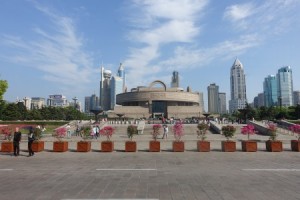
Leave a Reply
You must be logged in to post a comment.